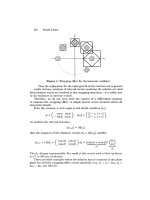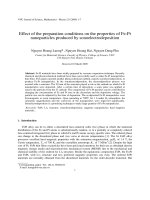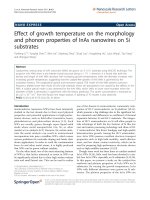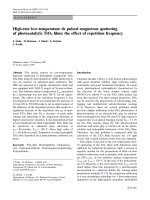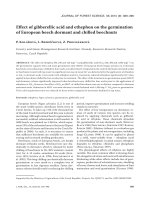Effect of low temperature on the germination of cucumber seeds
Bạn đang xem bản rút gọn của tài liệu. Xem và tải ngay bản đầy đủ của tài liệu tại đây (1.28 MB, 56 trang )
THAI NGUYEN UNIVERSITY
UNIVERSITY OF AGRICULTURE AND FORESTRY
DO THI QUYNH TRANG
EFFECT OF LOW TEMPERATURE ON THE GERMINATION
OF CUCUMBER SEEDS
BACHELOR THESIS
Study mode: Full-time
Major:
Environmental Science and Management
Faculty:
Advanced Education Program Office
Batch:
2014 - 2018
Thai Nguyen, 16/09/2018
DOCUMENT PAGE WITH ABSTRACT
Thai Nguyen University of Agriculture and Forestry
Degree program
Bachelor of Environmental Science and Management
Student name
Do Thi Quynh Trang
Student ID
DTN1454290031
Effect of low temperature on the germination of cucumber
Thesis Title
seeds
Dr. Duong Van Thao
Supervisor (s)
Assist. Prof. San-Gwang Hwang
Supervisor’s
signature (s)
Abstract: Poor seed germination is a common phenomenon at sub-optimal
temperatures which causes a great concern for farmers. Several priming treatments
have been reported to test for the seed resistance at different temperatures,
particularly at low temperatures. In this study, six cucumber cultivars (CU-87, CU127, Cuigu, Kappa summer no. 7, Kappa summer no. 11and CU-74) were used to
perform in four different temperatures (10℃, 15℃, 20℃ and 25℃), to compare the
germination and cold tolerance of seeds under low temperature conditions.
There are five experiments were performed and each experiment was run in three
replications. The results showed that cucumber was not suitable at low temperature
and tolerance of cucumber in poor chilling conditions. The germination was highest
at 25℃ and 20℃ but seeds also germinated readily at 15℃ and no germination was
observed at 10℃. Pre-treatment of seeds in hot water for 10 minutes had only minor
ii
effect on germination rate.
Key words:
Low temperature, chilling, germination, low treatment, rate
root, cucumber.
Number Pages:
45
Date of Submission:
16/09/2018
iii
ACKNOWDLEDGEMENT
I would like firstly
to emphasize the sincere appreciation to teachers in
Advance Education Program Office as well as teachers in Thai Nguyen University of
Agricultural and Forestry, who have taught me knowledge not only for my subjects but
also for my living skills and gave me a chance to do my thesis abroad. In addition, I
would like to thank all supports and help from Department of Horticulture, National
Chung Hsing University for the time I did my research in Taiwan.
It is my pleasure to work with a great teacher - Assistant Professor San-Gwang
Hwang, who always helped me any time. He also gave me the best conditions,
supported all materials for my research and discussed about any problems I got
whenever I did experiments in his Vegetable Laboratory. Indeed, without his help this
study would not have been possible. I am thankful that he provided me an opportunity
to establish my knowledge.
I would like to give special thanks to Dr. Duong Van Thao, who always
supported and cheered me up whole the time I worked over-sea. He also helps me a lot
on spending much time for checking my thesis report. I sincerely respect him for his
devotion to work, simplicity, his care, cooperation and encouragement during the
study period.
I consider it is an honor to work with Mr. Wayne, a master student, who
particularly helpful in guiding me toward a qualitative methodology and inspiring me
in whole period of internship time. He was always helpful, friendly and very kind with
me. Without his guidance, I cannot complete this thesis.
iv
Finally, I would like to express my gratitude to my family and friends, who
always beside me all the time. Their helps, supports and encouragement created the
pump leading me to success.
Sincerely,
Do Thi Quynh Trang
v
TABLE OF CONTENT
ACKNOWDLEDGEMENT .......................................................................................... iv
TABLE OF CONTENT ................................................................................................ vi
LIST OF FIGURES ..................................................................................................... viii
LIST OF TABLES ...................................................................................................... viii
LIST OF ABBREVIATIONS ....................................................................................... ix
PART I. INTRODUCTION ............................................................................................1
1.1. Research rationale ....................................................................................................1
1.2. Research objectives ..................................................................................................3
1.3. Research questions and hypothesis ..........................................................................3
1.3.1. Research questions ................................................................................................3
1.3.2. Hypothesis .............................................................................................................3
1.4. Limitations ................................................................................................................3
1.5. Definition ..................................................................................................................3
PART II. LITERATURE REVIEW ................................................................................6
2.1. An overview about the experiment...........................................................................6
2.2. Factors influence the germination of seeds ..............................................................8
2.2.1. Temperature ...........................................................................................................8
2.2.2. Ethylene (C2H4) and respiration production (CO2) ............................................10
2.2.3. Cell membrane on the germination of seeds .......................................................12
PART III. METHODS ...................................................................................................15
3.1. Materials .................................................................................................................15
3.2. Methods ..................................................................................................................16
vi
3.2.1. Germination test ..................................................................................................16
3.2.2. Root growth (Radicle length) ..............................................................................17
3.2.3. Relative electrical conductivity (EC) ..................................................................17
3.2.4. Respiration measurement (CO2) and ethylene measurement (C2H4) .................17
3.2.5. Statistics ...............................................................................................................18
PART IV. RESULT .......................................................................................................19
4.1. Final germination percentage (FGP), days to 50% germination and 80%
germination. ...................................................................................................................19
4.2. Root growth (Radicle length) .................................................................................21
4.3. Relative electrical conductivity (EC) .....................................................................27
4.4. Respiratory production rate (CO2) .........................................................................29
4.5. Ethylene production rate (C2H4) ............................................................................32
PART V. DISCUSSION AND CONCLUSION ...........................................................35
5.1. Discussion………………………………………………………………………………………….….35
5.2. Conclusion……………………………………………………………………………………….……36
REFERENCES ..............................................................................................................38
vii
LIST OF FIGURES
Figure 4.1 Effect of temperature on root growth for 7 days ............................... 24
Figure 4.2 The root of 6 cultivars at 10℃ after 7 days ....................................... 25
Figure 4.3 The root of 6 cultivars at 15℃ after 7 days ....................................... 25
Figure 4.4 The root of 6 cultivars at 20℃ after 7 days ....................................... 26
Figure 4.5 The root of 6 cultivars at 25℃ after 7 days ....................................... 26
Figure 4.6 Effects of tolerance on relativity electrolyte conductivity ................ 29
Figure 4.7 Seeds respiration rates at different temperature ................................ 31
Figure 4.8 Ethylene production rate change in seed within low temperature..... 34
viii
LIST OF TABLES
Table 3.1 Cucumber seeds information ...................................................... 16
Table 4.1 Germination ability at four temperatures in six cucumber
cultivars ....................................................................................................... 19
Table 4.2 Effect of germination temperature on the time to 50%
germination.................................................................................................. 21
Table 4.3 Effect of germination temperature on the time to 80%
germination.................................................................................................. 21
ix
LIST OF ABBREVIATIONS
CO2
The respiration
C2H4
The ethylene
EC
Electrical conductivity
EC0
Electrical conductivity of the seeds after put in 4 different temperature
levels for 24 hours
EC1
Electrical conductivity of the seeds after bath in 95℃ hot water for 1 hour
x
PART I. INTRODUCTION
1.1. Research rationale
The phrases climate change and global warming and more recently global
cooling are now part of our life. Climate change has come upon us in a relatively short
space of time and is accelerating with alarming speed. It is perhaps the most serious
problem that the civilized world has had to face. Earth’s climate is in a nonstop state of
change; it is inherent in the dynamic nature of our planet. Changes in the basic
components that influence the state of the Earth’s climatic system can occur externally
(from extraterrestrial systems) or internally (from oceans, atmosphere, and land
systems) through any one of the described components. For example, an external
change may include a variation in the sun’s production which would externally vary
the amount of solar radiation received. Internal variations in the Earth's climate system
may be due to changes in atmospheric concentrations, mountain formation, volcanic
activity, and surface or atmospheric changes. These forces will continue to have a
major effect on our future climate.
The influence of global warming is now can be seen in many parts of the world.
Abnormality in climate patterns, caused by rapid warming, have begun to affect a
catchment specific hydrologic cycle. Scientists believe that rapid warming in the last
several decades are mostly due to human induced changes in the atmosphere, on top of
some natural variations. Impacts of climate change are complex as they can be both
direct and indirect, the biggest casualty being natural resources such as agriculture and
horticulture. High temperatures lead to a high rate of evaporation and dry conditions in
some areas in the world. Severe weather events are now more common. Environmental
1
stresses shows the most important limiting conditions for horticultural productivity and
plant exploitation worldwide. Climate change has led to erratic weather, where long
droughts and severe freezing occur greatly affecting the growth of crops, one of those
is cucumbers.
Cucumber (Cucumis sativus L.), a warm-season crop, germinates at optimal
temperatures of 24 to 28°C (Staub and Wehner 1996). Fluctuating temperatures
encountered in many production areas during the early part of the growing season may
negatively influence germination and seedling growth in cucumber (Kłosińska et al.,
2013). Cultivars with low temperature tolerance are currently unavailable, although
differences in response to chilling temperatures were found among the cultivars
present on the market. Cucumber cultigens differ in their requirements for the optimal
and minimal temperature or germination (Kłosińska et al., 2013). This might be
associated with the geographic region they originated from. Lower (1975)
demonstrated that 11 cucumber cultivars exhibited differences in germination speeds
at temperatures between 14 and 17°C. Cultivars developed in the northern part of the
United States were better cold germinators than those developed in the southern part of
the U.S. The exception was ‘Pixie’, with good cold germination ability even it
originating from the South. Similarly, Wehner (1981, 1982) found differences in days
to germination at 15℃ among 203 cucumber breeding lines and cultivars (from 3.5 to
17.3), but not at 20°C. Significant differences were found also among 15 cucumber
cultivars when germinated at 15°C, but not at 25°C.
In this study, we wanted to conduct experiments on 6 cultivars originating from
Japan, which is: CU-87, CU-127, Cuigu, Kappa Summer no. 7, Kappa Summer no. 11,
2
and CU-74. To test how the low temperature affects the germination of seeds of
cucumber and which temperature levels are appropriate for the development of this plant.
1.2. Research objectives
The main purpose of this research is to identify how low temperature affected the
germination and growth of cucumber seeds and where is suitable temperature for the
development of these type of seeds.
1.3. Research questions and hypothesis
1.3.1. Research questions
The study aims to address the following questions:
- Does the low temperature might not affect the germination and growth of
cucumber seeds?
- What are the ideal temperatures for the grow of cucumber seeds?
1.3.2. Hypothesis
- H0 (Null hypothesis): Cucumber seeds will not affect by low temperature.
- Ha (Alternative hypothesis): Cucumber seed will affect by low temperature.
1.4. Limitations
Japanese cucumber seeds were grown under cold conditions. Because individual
seed adapted differently to the environmental temperature, therefore some of
experimental results were not completely accurate.
1.5. Definition
3
- Cucumber (Cucumis sativus L.)
Cucumber is a type of flowering plant that regarding to the pumpkin family. This
plant originates from South Asia. Cultivation of cucumber started 3000 years ago in
India and it quickly spread out to the rest of the world. Cucumber was popular and
often used type of vegetable in the ancient Egypt and Rome. It is still one of the most
widely used plants in human meal. Cucumber grows best in warm condition,
subtropical climate, in sunny areas on a fertile and well drained soil. People plant
cucumbers mostly as a source of food. Some kinds of cucumber are cultivated in
ornamental purposes.
Most seeds of the cucumber (Cucumis sativus L.) produce long, slender
cucumbers that have skins that are thin enough to be eaten without being peeled.
While almost seeds produce either slicing or pickling cucumbers, there are hybrid and
foreign varieties that may notice the home gardener. Do not gather seeds for planting
from cucumbers that are at the eating stage. These seeds are not mature and will not
germinate. Let the cucumbers developed before you collect the seeds. Collect
cucumbers to select seeds at the end of the growing season.
- Electrical conductivity (EC):
EC stands for electrical conductivity, which determine the potential for a material
to conduct electricity. Even though most farmers are familiar with measuring the
amount of feeding that they have to give in ounces per gallon, grams per liter, or any
other measuring units used, EC goes a little further than this. When growing, it is
important to have a good understanding of what EC is all about and its significance to
the farmer.
4
In this study EC is based on the fact that seeds, when soaked in water, exude
ions, sugars and other metabolites, from the starting of the soaking period, due to
change in the integrity of the cell membranes, as a function of water amount and of the
level of seed deterioration (Fessel et al., 2006). In deteriorated seeds, the repair
mechanism is absent or inefficient, or the membranes are completely damaged, thus
permitting leaching of larger electrolyte amounts.
5
PART II. LITERATURE REVIEW
The quality of seeds germination is determined by all its performance
determining properties, such as temperature, ethylene and respiration production, cell
membrane. Many factors at each process unit which can influence the germination
quality. These factors can be measured by various techniques.
2.1. An overview about the experiment
Chilling injury is a physiological disorder that occurs in sensitive plants
subjected to non-freezing temperatures below 12°C (Saltveit and Morris 1990).
Sensitive plants include those of tropical and subtropical origin (e.g., avocados,
bananas, cotton, maize and rice) and some temperate plants (e.g., asparagus and some
apple cultivars). Symptoms of chilling injury include stunted growth, reduced
photosynthetic capacity, necrosis and discoloration, abnormal ripening and increased
disease susceptibility (Mary E. Mangrich and Mikal E. Saltveit 2000). Chilling
sensitivity restricts the length of the growing season, limits the geographical area
available for cultivation and requires the storage temperature of harvested
commodities to be at least 10°C higher than the optimum 0°C storage temperature
recommended for most chilling-tolerant crop (Mary E. Mangrich and Mikal E. Saltveit
2000). While many hypotheses have been offered to explain the cellular basis for
chilling injury, a phase transition of cellular membranes is still thought to be the initial
step in a chain of events that result in chilling injury (Lyons and Raison 1970).
Radicle root growth after chilling is a sensitive indicator of chilling stress, more
sensitive than the frequently used measure of ion leakage (Saltveit and Morris 1990).
This difference in sensitivity is shown by comparing the incremental decrease in
6
subsequent elongation of the cucumber (Cucumis sativus L.) radicle after a few days of
chilling with the significant increase in the rate of ion leakage from the radicle that
only occurs after 3 days of chilling (Jennings and Saltveit 1994). Above zero
temperatures need to occur over at least 6 weeks for angiosperm survival (Körner,
2011). Results of earlier works have indicated that tissue formation, irrespective of
whether above or below ground, becomes very slow at or below 5°C
(ALVAREZ‐URIA P. and KƯRNER C. 2007); (Kưrner, 2008); (Sebastian et al., 2016)
and was never observed at or below 0°C, a temperature that still permits CO2 uptake
at ca. 30% of photosynthetic capacity. In addition to the factors mentioned above the
role of ethylene in seed germination has been extensively studied in several species
("Index," 1992) and it was observed that ethylene may be involved in the removal of
inhibitors and thus derepress germination (Bewley J. et al., 2013), especially under
stress conditions. A possible mechanism of seed priming in circumventing thermo
inhibition of carrot seeds would be by increasing ethylene production during
germination at high temperatures because in low temperature there is no ethylene
production.
Seed vigor has been defined as ‘a physiological property determined by the
genotype and modified by the environment, which governs the ability of a seed to
produce a seedling rapidly in soil and the extent to which that seed tolerates a range of
environmental factors’ (Mary E. Mangrich and Mikal E. Saltveit 2000) concluded that
seeds with high vigor are more tolerant of environmental stress.
The present work was undertaken to investigate the effect of heat shock on the
subsequent growth of cucumber radicles chilled for different lengths of time. We also
7
examine the relationship between the vigor of germinating seeds and their response to
chilling temperatures.
2.2. Factors influence the germination of seeds
To obtain a good quality in the term of seeds germination, there several factors
which control the quality of its temperature, the ethylene and respiration production,
and cell membrane.
2.2.1. Temperature
Appropriate temperature is probably the most important factor in adjusting
germination (Nerson, 2007). Temperature affects the germination capacity, the
germination rate and the germination frequency alongside the incubation time (Kurtar,
2010). Germination speed frequently increases until the temperature reaches 30 - 35°C
(Roberts and Ellis 1989). Temperature has significant influence on the onset, potential
and rate of germination (Flores and Briones 2001).
The thermal limits for germination are defined by the minimum, optimum and
maximum temperatures which can determine some of the ecological limitations for the
geographic distribution of the species. Optimum temperature is the temperature value
which results in the highest germination speed (Håkansson et al., 2002). Ideal
temperatures produce both the most rapid seed germination and plant growth. The
ideal temperature for germination rate is typically higher than that required to reach
maximum percentage germination in partially dormant or partially deteriorated seed
populations.
The effects of temperature on seed germination and emergence for some species
have been examined through modelling, as well as under field or laboratory
8
conditions. Kevseroglu et al., (2000) carried out studies using some industrial plants,
in sugar beet (Dürr et al., 2001), in some vegetable crops, in peach (Malcolm et al.,
2003), in Legume crops (Kurtar et al., 2004), in wheat (Jame and Cutforth 2004), in
tobacco (Cırak et al., 2007), in grain legumes and cereals (Odabas and Mut 2007), in
some brassica species (Balkaya et al., 2008), in corn. Models have been consumed by
many researchers to determine plant growth potential, development and yield
(Prusinkiewicz, 2004); (Yang et al., 2004), as well as seed germination, seedling
emergence times, and seedling growth potential, in recent years (S. P. Hardegree et al.,
2003); (Stuart P. Hardegree, 2006). These models can be developed for different
environmental conditions and different agricultural crops and can be used for
accurately forecasting long term crop responses.
Low temperature is detrimental to plant growth and development and thus affects
the productivity of important warm-season food crops worldwide. Cucumbers
(Cucumis sativus), like all members of the pumpkin family, need a long, warm
growing season to produce juicy, high quality fruit. Their small oval seeds germinate
quickly in warm weather but may germinate slowly or are susceptible to low
temperatures throughout its growth cycle. In general, cucumbers are best cultivated in
late spring or early summer. Numerous mechanisms have been suggested to account
for chilling or tolerance in plants. Some of the changes related to cold temperature
stress involve alterations in gene expression, proteins, lipids, carbohydrate
composition, membrane properties, solute leakage, mitochondrial respiration, and
photosynthesis.
9
2.2.2. Ethylene (C2H4) and respiration production (CO2)
The growth and development of higher plants, from the earliest to the most
advanced stages of the life cycle, are strictly regulated by phytohormones, such as
ethylene (Fluhr and Mattoo 1996). Germination, flowering, maturation, senescence
and response to pathogens are some of the processes that involve this two-carbon
alkene. Ethylene is a naturally produced, simple two carbons gaseous plant growth
regulator that has numerous effects on the growth, development and storage life of
many fruits, vegetables and ornamental crops. This powerful plant hormone is
effective at part-per-million (ppm, ml l−1) to part-per-billion (ppb, ml l−1)
concentrations.
Both the synthesis and action of C2H4 involve complicated metabolic processes,
which require oxygen and are sensitive to elevated concentrations of carbon dioxide.
Endogenous sensitivity to C2H4 changes during plant development, as does its rate of
synthesis and loss by diffusion from the plant (Matilla, 2007).
Although the great majority of seeds produce ethylene during the germination
process, it is not yet clear whether this gas acts as a phytohormone in the chain of
germination events, or whether C2H4 production is a result of, rather than a
requirement for, germination and consequently does not alter the pattern of events
prior to or during the breaking of the seed coat (Nascimento et al., 2013). A number of
papers will be reviewed to shed more light on this enigma. Various studies have
demonstrated that C2H4 production in certain seeds increased before radicle
protrusion, and this protrusion was reduced on trapping the ethylene produced.
10
Seed germination involves a series of hormonally regulated metabolic processes.
Consequently, as germination involves the revival of the growth of the organ that
breaks the seed coat, this part of the seed may contain the true target cells for certain
phytohormones (e.g. ethylene; Kieber, 1997). In lettuce, it has been suggested that
ethylene is necessary for germination at supra-optimal temperatures (Nascimento et
al., 2000); (Kozareva et al., 2004).
As well as C2H4, the CO2 of seeds during germination also plays an important
role in the ability of the seed to survive in extreme climatic conditions. Germination of
a seed starts with water absorb by the seed. This is an essential stage for the seed to
germinate. The total water takes up is about 2-3 times the weight of the seed. Whether
or not a viable seed will germinate depends on a various factor. The chemical
environment of the seed must be suitable. Water must be available, oxygen has to be
present since the seed must respire and dangerous chemicals should not be present.
The physical environment must also be favorable. The temperature must be proper as
well as the light quality and quantity.
Many techniques have been studied to improve germination and emergence at
low temperature. One successful seed treatment that increases seed vigor is
osmoconditioning or priming. Promising results have been observed in vegetable
crops. Germination is an energy-requiring process, dependent on the respiration of the
seed (Mayer and Poljakoff-Mayber 1965). Respiratory activity is initiated upon
imbibition, but may be delayed or reduced by low temperatures or reduced water
potentials (Dahal et al., 1996). Respiration rates of seeds in the early stages of
germination have been positively correlated with seedling development
11
(Woodstock W. and Pollock M., 1965). However, little information is available on
seed respiratory characteristics of different cultivars in relation to their capacity to
germinate under low temperatures. Furthermore, these relation-ships are not clear, e.g.
in soybean and maize (Van de Venter A. and Grobbelaar 1985; Ismail M. et al., 1989).
Low temperature positively affected seed respiration in spinach, kohlrabi and eggplant
(Mazor et al., 1984), but contrasting results were obtained among different pepper
cultivars.
2.2.3. Cell membrane on the germination of seeds
As the first essential step of the plant life cycle, seed germination is an important
part of crop growth. Depending on the rate of water uptake, the time course of
germination and subsequent growth is divided into three phases (Xiaomei et al., 2015).
In phase I, which is also called imbibition, water uptake is rapid; in phase II, water
uptake is much slower and reaches a plateau; in phase III (post-germination), there is
an increase in water uptake (Bewley J. D., 1997; Weitbrecht et al., 2011). Imbibition is
negatively affected by high rates of water uptake and low temperatures. Low
temperatures reduce the speed and/or rate of germination through imbibition chilling
injury. Imbibition chilling injury is a common problem in agriculture (Cheng et al.,
2009) and has been reported for a wide range of crops, including bean and lima bean
(Pollock, 1969), cotton (Christiansen, 1967), pea, cucumber (Makeen et al., 2006), and
corn and soybean (Hobbs and Obendorf 1972). Imbibition has attracted wide and longlasting interest from researchers.
The
most important event during imbibition is probably membrane
reorganization, given that it occurs before other events and is a precondition for most
12
cellular process (W., 1974). Adoption of the hexagonal II phase of membrane
(Ishibashi et al., 2013), contributes to substantial cytoplasmic leakage upon hydration
(Lyons, 1973). Membranes must quickly reorganize from a hexagonal II phase to a
lamellar phase in order to restore normal function and to terminate leakage of cellular
components (Villa-Hernández et al., 2013). Against this background, the widely
accepted model for imbibition chilling injury is that a low temperature disrupts
membrane reorganization.
Plant membranes mainly consist of glycerolipids, including six classes of
phospholipids: phosphatidylcholine, phosphatidylethanolamine, phosphatidylinositol,
phosphatidylserin, phosphatidic acid, and phosphatidylglycerol, and two classes of
galactolipids: monogalactosyldiacylglycerol and digalactosyldiacylglycerol, which are
plastid lipids. In comparison with the lipid composition in leaves, seed membranes
have low levels of both monogalactosyldiacylglycerol and digalactosyldiacylglycerol,
and high levels of phosphatidic acid (Crowe and Crowe 1992). The low levels of
monogalactosyldiacylglycerol and digalactosyldiacylglycerol result from the lack of
plastids in seeds. The high level of phosphatidic acid probably results from the drying
during seed maturation because desiccation usually induces its formation (Devaiah et
al., 2006; Francisco et al., 2013), moreover, a high level of phosphatidic acid in
membranes favors formation of the hexagonal II phase (Verkleij et al., 1982). Besides
its specific role in membrane structure, phosphatidic acid is also a central intermediary
(phosphatidic acid pool) in lipid metabolism pathways for both storage and membrane
lipids (Francisco et al., 2013). Given the importance of storage lipid catalysis, the
phosphatidic acid pool could have critical functions during germination. Under
13
conditions of dehydration and low temperature, phosphatidic acid is derived mainly
from phospholipase D-mediated hydrolysis of phospholipids (Zhang et al., 2013).
14
PART III. METHODS
3.1. Materials
Seeds material: The cucumber is almost annual production in Taiwan, so the
farmer prefers to choose which have the following characteristics, like parthenocarpy,
high gynoecium (female flower) at main vine or side vine, high production and which
can be planted throughout the year, like the CU series and the Kappa summer series.
- CU series: Japanese cucumber, the fruit color was dark green with luster, high
yield, and good storability (CU-87 have high temperature resistance; the main vine
production can be harvest earlier. CU-127 has downy mildew and low temperature
resistance, which is suitable for autumn and winter cultivation).
- Kappa summer: Japanese cucumber, the fruit color was light green with white
thorns, have heat resistance (Kappa summer no.11 have powdery mildew resistance,
one fruit position can form 2 female flowers).
- Cuigu: Taiwanese cucumber, the fruit color was dark green with luster, high
yield, suitable for summer cultivation.
15

